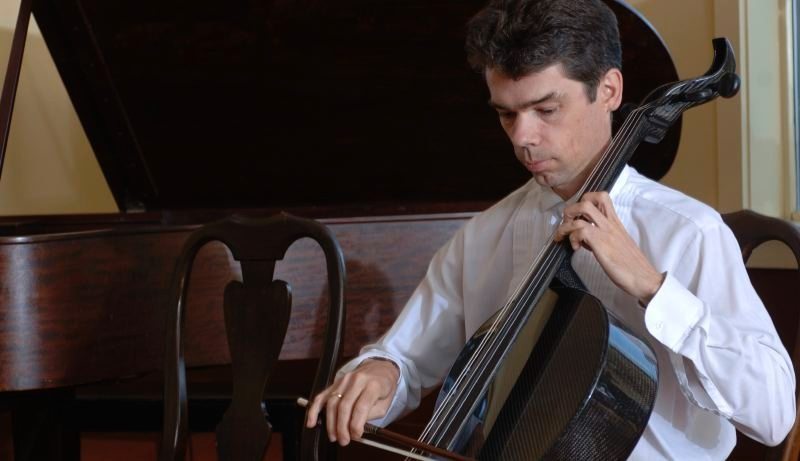It’s lighter, cheaper and it turns heads in the pit: Derek Gomez plays his $7,500 (Canadian dollars) space-age cello.
Bill Rankin, The Edmonton Journal
Saturday, January 03, 2004
EDMONTON – Derek Gomez is a quiet man, an analytical man. Behind his reserved exterior, though, the Edmonton Symphony cellist is also what you might call a practical revolutionary.
Without warning, a few months ago, he showed up for work with a carbon fibre cello. In a world where old wood talks, bringing in a composite instrument could have been seen as deviant. Classical musicians can be a conservative lot, but Gomez says his five playing mates in the cello section were intrigued.
“They were all immediately impressed with it although they wouldn’t give up their wooden cellos,” says Gomez. “They’ve been really receptive.”
Colin Ryan, the ESO’s principal cellist, says after a period of adjustment, the high-tech instrument has fit into the section just fine. And Ryan is hankering for a chance to get to know better what it can do. “It really piques your imagination.”
Ryan says he was trying to persuade Gomez to let him play it for an evening during the recent Nutcracker run or to take it home for a weekend.
The instrument compares favourably to the traditional wooden one, and it’s considerably less expensive.
“It’s surprising it has the quality of instruments costing many times more. I can tell you if a young player was looking at me saying what should I buy to move up, I’d say you should really consider it,” Ryan says. Gomez’s late-19th-century Italian cello cost him $20,000 years ago, a paltry sum for a professional instrument. A Stradivarius, a Guarneri or a Montagnana costs millions as compared with the carbon fibre instrument’s $7,500 price tag. Gomez says he’s always been open to new ideas, but his first contact with the synthetic instrument world didn’t come from some great leap of the imagination. He needed a cello that wouldn’t break. A couple of summers ago, he was hired to play chamber music for whitewater rafters going down the Colorado River into the Grand Canyon for two weeks. He’d heard about an Arizona company called Quintus that made carbon fibre cellos. He thought about protruding rocks and cold water, and asked the company if he could borrow one of their virtually indestructible instruments for the wilderness gig. They could post what turned out to be his positive review on their Web site later. He found he liked the instrument beyond its physical resilience.
“I thought it was such a cool thing to have,” he recalls.
For the next year, Gomez mulled over the idea of getting a space-age cello for himself.
“I’ve always been intrigued by new ideas on ways to improve upon what we do. And I’ve always looked at my instrument as basically just a tool, as a way of transmitting human expression. In that sense it’s not all about the instrument. It’s all about what you project through that tool.”
Gomez made the move, but he didn’t go with a Quintus cello. He’d heard about a Boston company and was especially impressed that its cellos were developed by an admired musician who has been one of the 11 cellists in the prestigious Boston Symphony for 40 years. The Luis & Clark cello testimonials from other BSO musicians were also convincing. It didn’t hurt that the world’s most famous cellist, Yo-Yo Ma, had played a Luis & Clark cello in an outdoor July 4 concert and said good things about the instrument. In an interview with CNN’s Paula Zahn, Ma told the world, “You can see I have a really interesting cello. It also serves as a barbecue. … I love this instrument.” Gomez got a hold of Luis Leguia, the instrument’s inventor, and had a cello sent to Edmonton with the guarantee it could be returned if the ESO player didn’t like it.
“I went on the premise that if this guy was playing it, it must be good. He mailed it up to me and I’ve been loving it ever since,” Gomez says. Leguia says Gomez is the only Canadian musician to own one of his carbon fibre cellos.
A cursory survey of other Canadian orchestras confirmed reports that Gomez is the only Canadian professional using one. (A Toronto Symphony player did offer to be interviewed about his graphite tennis racket, however.)
Leguia took 10 years to perfect his design and enlisted the expertise of Steve Clark to manufacture the cellos. Clark has built prize-winning Little Americas Cup C-class catamarans using carbon fibre.
The Boston cellist says he usually plays one of his expensive wooden instruments in symphony concerts, but he uses his carbon fibre instrument exclusively for solo recitals.
Gomez still plays his wooden cello, especially for his Alberta Baroque Ensemble concerts. The old look fits better with the old music. But he’s excited by the new technology’s potential.
“I think with modern-age science, we can maybe get closer to what’s in your head by making it easier to interpret that through your hands. That’s my goal. I just like being part of this discovery.”
He teases that the new instrument might call for a new concert wardrobe, as well.
“I think I should update my uniform. A leather tuxedo, I think.”

